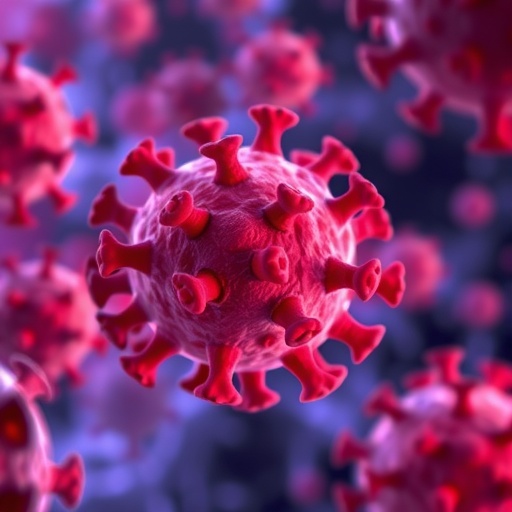In a groundbreaking study that may redefine therapeutic strategies for acute lymphoblastic leukemia (ALL), researchers have uncovered the prognostic significance of immune checkpoint molecules, particularly Galectin-9 (Gal9), expressed on leukemia stem cells (LSCs). Immune checkpoint inhibitors (ICIs) have transformed cancer treatment by unleashing the body’s own T cells to attack tumor cells. However, their application in hematological malignancies such as ALL remains insufficiently explored. This new investigation offers an unprecedented and comprehensive analysis of two pivotal immune checkpoints—PD1/PDL1 and TIM3/Gal9—and their expression patterns across both T-lymphocytes and leukemia stem cells in ALL patients.
The study focused heavily on the bone marrow microenvironment, where the interplay between immune cells and malignant blasts dictates disease progression and response to therapy. Using sophisticated flow cytometry techniques, the researchers quantitatively analyzed the levels of PD1 and TIM3 on bone marrow T-lymphocytes, as well as PDL1 and Gal9 on blast cells and leukemia stem cells from 85 newly diagnosed ALL patients. This dual assessment is vital because while immune checkpoints on T cells are known to regulate immune evasion, their ligands on tumor cells, particularly stem-like cells that sustain disease relapse and resistance, are less understood.
One of the most striking findings was the differential prognostic value associated with the expression levels of these immune checkpoint molecules. While some markers correlated with adverse clinical parameters, others surprisingly aligned with favorable prognoses. This paradox highlights the complex, multifaceted nature of immune checkpoints in the leukemic microenvironment. Notably, expression of Gal9 on LSCs emerged as a robust independent prognostic indicator, distinguishing it as a potential biomarker for disease progression and patient survival.
Galectin-9 belongs to the family of β-galactoside-binding lectins and plays a critical role in immune modulation. Its interaction with TIM3 on T cells can suppress immune responses, but in the context of leukemia stem cells, Gal9 appears to influence not only immune evasion but also intrinsic leukemic biology. The inverse correlation observed between Gal9 expression and the proportion of LSCs (r = -0.414, p < 0.001) suggests a nuanced regulatory mechanism in which higher Gal9 levels might restrict the expansion of malignant stem cells or mark a biologically distinct subset of LSCs.
Further analysis revealed that low Gal9 expression on LSCs was associated with significantly poorer overall survival (OS) and progression-free survival (PFS), independent of other prognostic factors. This discovery is particularly noteworthy as it indicates that quantitative assessment of Gal9 could be integrated into clinical risk stratification models, allowing for more personalized therapeutic approaches in ALL.
These insights pave the way for new avenues of targeted therapy. Traditionally, ICIs aim to reinvigorate exhausted T cells by blocking PD1 or TIM3 signaling. However, this study illuminates the therapeutic potential of directly targeting Gal9 on leukemia stem cells. By disrupting Gal9-mediated signaling, it may be possible to eradicate the resilient LSC population responsible for minimal residual disease and subsequent relapse.
Moreover, the study underscores the complexity of immune checkpoint biology in hematological cancers. Unlike solid tumors where high checkpoint expression typically portends worse outcomes, in ALL the relationship is more intricate. Immune checkpoints may play dual roles, acting as both facilitators of immune escape and regulators of leukemic stem cell function. This duality emphasizes the necessity to examine both immune cells and malignant cells concurrently instead of in isolation.
Implementing these findings into clinical practice warrants further investigation. Future studies should explore whether therapeutic agents designed to modulate Gal9 expression or function on LSCs can improve disease control and patient survival in ALL. Additionally, exploring combinatory regimens that simultaneously target immune checkpoints on T cells and ligands on leukemia cells might enhance antileukemic responses without compromising immune homeostasis.
This research also highlights the importance of longitudinal monitoring of immune checkpoints during therapy. Immune landscape alterations under chemotherapeutic or immunotherapeutic pressure may affect the expression of PD1/PDL1 and TIM3/Gal9, ultimately influencing treatment efficacy. Comprehensive immunophenotyping throughout disease course could inform adaptive treatment strategies.
The use of flow cytometry to dissect the immune checkpoint profiles in the bone marrow microenvironment represents an advanced methodological approach, providing high-resolution data on cell population-specific expression. Such detailed profiling is essential to unravel the heterogeneity of ALL and customize therapies accordingly.
Additionally, the findings challenge researchers to rethink the conventional binary of immune checkpoints as merely ‘on/off’ switches for T cell activation. Instead, checkpoint molecules and their ligands comprise a dynamic signaling network, where cellular context and expression level dictate functional outcomes, including direct effects on tumor cell biology.
In conclusion, the identification of Gal9 expression on leukemia stem cells as an independent prognostic parameter marks a paradigm shift in understanding ALL pathogenesis and immune evasion. It opens promising channels for innovation in biomarkers and targeted therapy, moving closer to curative strategies for this aggressive hematologic malignancy. This comprehensive investigation offers hope for leveraging immune checkpoint biology to overcome therapeutic resistance and improve clinical outcomes in ALL.
The implications of this study extend beyond ALL, as uncovering the dual roles of immune checkpoints on malignant stem cells may apply to a broad range of cancers. The intricate crosstalk between immune cells and tumor stem populations stands as a frontier in cancer immunology, potentially transforming how immunotherapies are designed and deployed in the near future.
Subject of Research: Immune checkpoint inhibitor expression (PD1/PDL1 and TIM3/Gal9) in acute lymphoblastic leukemia, with a focus on Galectin-9 expression on leukemia stem cells as an independent prognostic factor.
Article Title: PD1/PDL1 and TIM3/Gal9 expression in acute lymphoblastic leukemia: Gal-9 expression on leukemia stem cells as an independent prognostic parameter.
Article References:
Kamel, A.M., Almuslimani, A.M., Kandil, E.Z. et al. PD1/PDL1 and TIM3/Gal9 expression in acute lymphoblastic leukemia: Gal-9 expression on leukemia stem cells as an independent prognostic parameter. BMC Cancer 25, 1421 (2025). https://doi.org/10.1186/s12885-025-14856-9
Image Credits: Scienmag.com




